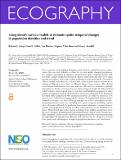Files in this item
Using density surface models to estimate spatio-temporal changes in population densities and trend
Item metadata
| dc.contributor.author | Camp, Richard J. | |
| dc.contributor.author | Miller, David L. | |
| dc.contributor.author | Thomas, Len | |
| dc.contributor.author | Buckland, Stephen T. | |
| dc.contributor.author | Kendall, Steve J. | |
| dc.date.accessioned | 2020-05-12T15:30:05Z | |
| dc.date.available | 2020-05-12T15:30:05Z | |
| dc.date.issued | 2020-07 | |
| dc.identifier | 267831841 | |
| dc.identifier | c9ad9a97-59ca-4f42-a7b2-192b2d886ce7 | |
| dc.identifier | 85083044933 | |
| dc.identifier | 000544487400012 | |
| dc.identifier.citation | Camp , R J , Miller , D L , Thomas , L , Buckland , S T & Kendall , S J 2020 , ' Using density surface models to estimate spatio-temporal changes in population densities and trend ' , Ecography , vol. 43 , no. 7 , pp. 1079-1089 . https://doi.org/10.1111/ecog.04859 | en |
| dc.identifier.issn | 0906-7590 | |
| dc.identifier.other | ORCID: /0000-0002-7436-067X/work/74117826 | |
| dc.identifier.other | ORCID: /0000-0002-9939-709X/work/74117829 | |
| dc.identifier.other | ORCID: /0000-0001-7008-923X/work/74118148 | |
| dc.identifier.uri | https://hdl.handle.net/10023/19925 | |
| dc.description | Funding – Centre for Research into Ecological and Environmental Modelling, University of St Andrews and U.S. Geological Survey provided funding for this analysis through a studentship to RJC. | en |
| dc.description.abstract | Precise measures of population abundance and trend are needed for species conservation; these are most difficult to obtain for rare and rapidly changing populations. We compare uncertainty in densities estimated from spatio–temporal models with that from standard design‐based methods. Spatio–temporal models allow us to target priority areas where, and at times when, a population may most benefit. Generalised additive models were fitted to a 31‐year time series of point‐transect surveys of an endangered Hawaiian forest bird, the Hawai'i ‘ākepa Loxops coccineus. This allowed us to estimate bird densities over space and time. We used two methods to quantify uncertainty in density estimates from the spatio–temporal model: the delta method (which assumes independence between detection and distribution parameters) and a variance propagation method. With the delta method we observed a 52% decrease in the width of the design‐based 95% confidence interval (CI), while we observed a 37% decrease in CI width when propagating the variance. We mapped bird densities as they changed across space and time, allowing managers to evaluate management actions. Integrating detection function modelling with spatio–temporal modelling exploits survey data more efficiently by producing finer‐grained abundance estimates than are possible with design‐based methods as well as producing more precise abundance estimates. Model‐based approaches require switching from making assumptions about the survey design to assumptions about bird distribution. Such a switch warrants carefully considered. In this case the model‐based approach benefits conservation planning through improved management efficiency and reduced costs by taking into account both spatial shifts and temporal changes in population abundance and distribution. | |
| dc.format.extent | 11 | |
| dc.format.extent | 905337 | |
| dc.language.iso | eng | |
| dc.relation.ispartof | Ecography | en |
| dc.subject | Density estimation | en |
| dc.subject | Distance sampling | en |
| dc.subject | Point-transect sampling | en |
| dc.subject | Spatio–temporal smoother | en |
| dc.subject | Variance propagation | en |
| dc.subject | QE Geology | en |
| dc.subject | QH301 Biology | en |
| dc.subject | Ecology, Evolution, Behavior and Systematics | en |
| dc.subject | DAS | en |
| dc.subject | MCP | en |
| dc.subject.lcc | QE | en |
| dc.subject.lcc | QH301 | en |
| dc.title | Using density surface models to estimate spatio-temporal changes in population densities and trend | en |
| dc.type | Journal article | en |
| dc.contributor.institution | University of St Andrews. Statistics | en |
| dc.contributor.institution | University of St Andrews. School of Mathematics and Statistics | en |
| dc.contributor.institution | University of St Andrews. Centre for Research into Ecological & Environmental Modelling | en |
| dc.contributor.institution | University of St Andrews. Applied Mathematics | en |
| dc.contributor.institution | University of St Andrews. Marine Alliance for Science & Technology Scotland | en |
| dc.contributor.institution | University of St Andrews. Scottish Oceans Institute | en |
| dc.contributor.institution | University of St Andrews. St Andrews Sustainability Institute | en |
| dc.identifier.doi | https://doi.org/10.1111/ecog.04859 | |
| dc.description.status | Peer reviewed | en |
This item appears in the following Collection(s)
Items in the St Andrews Research Repository are protected by copyright, with all rights reserved, unless otherwise indicated.

